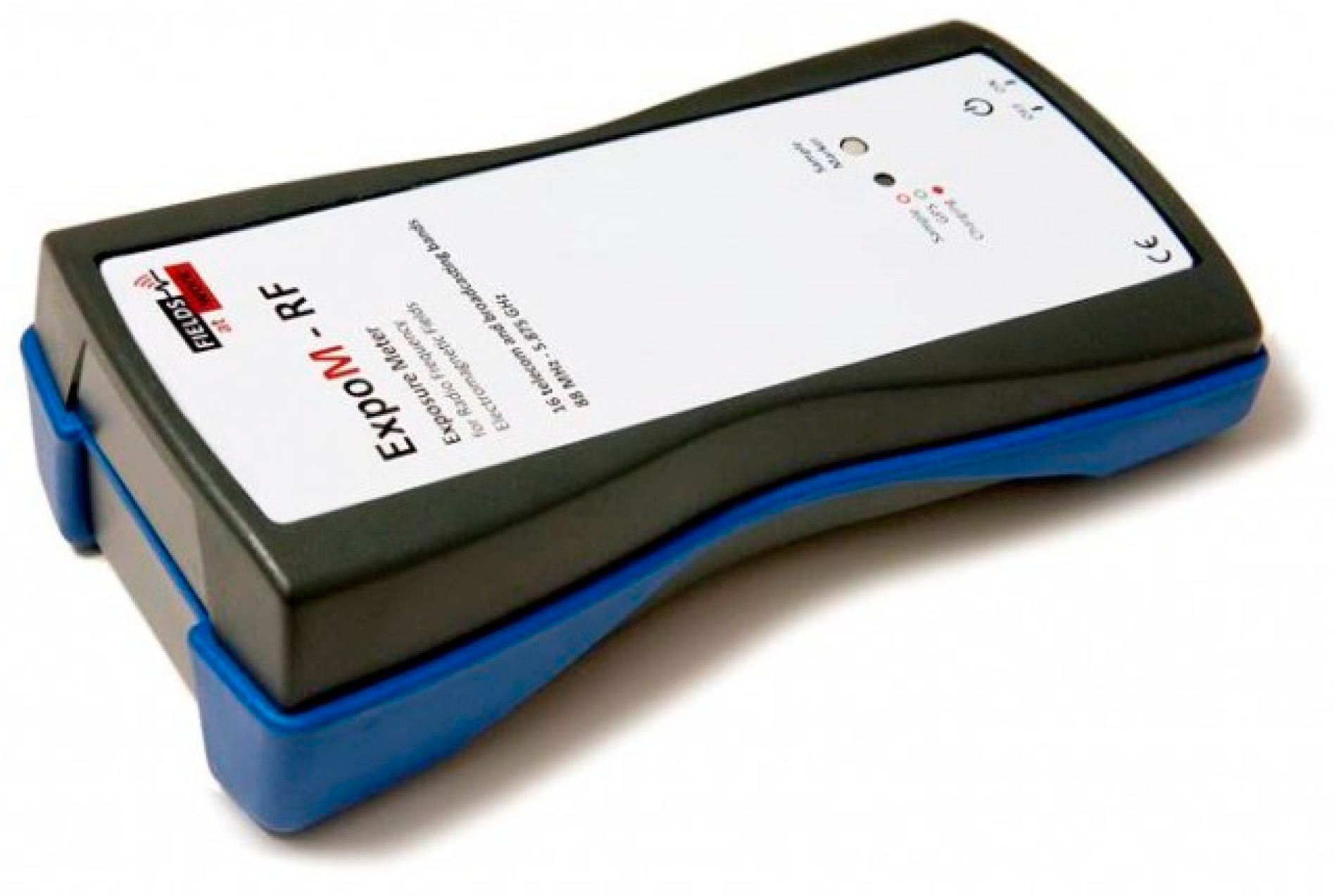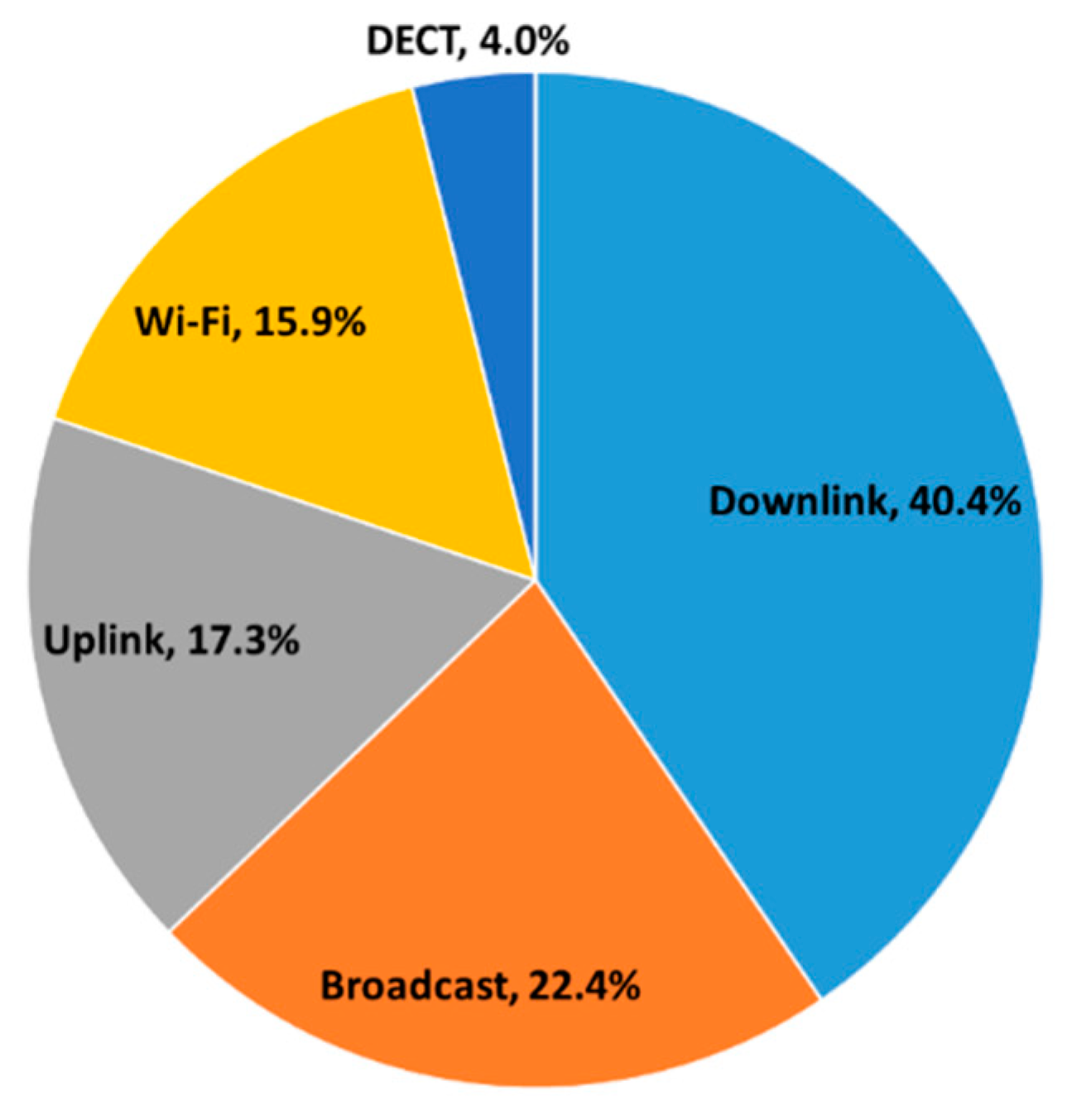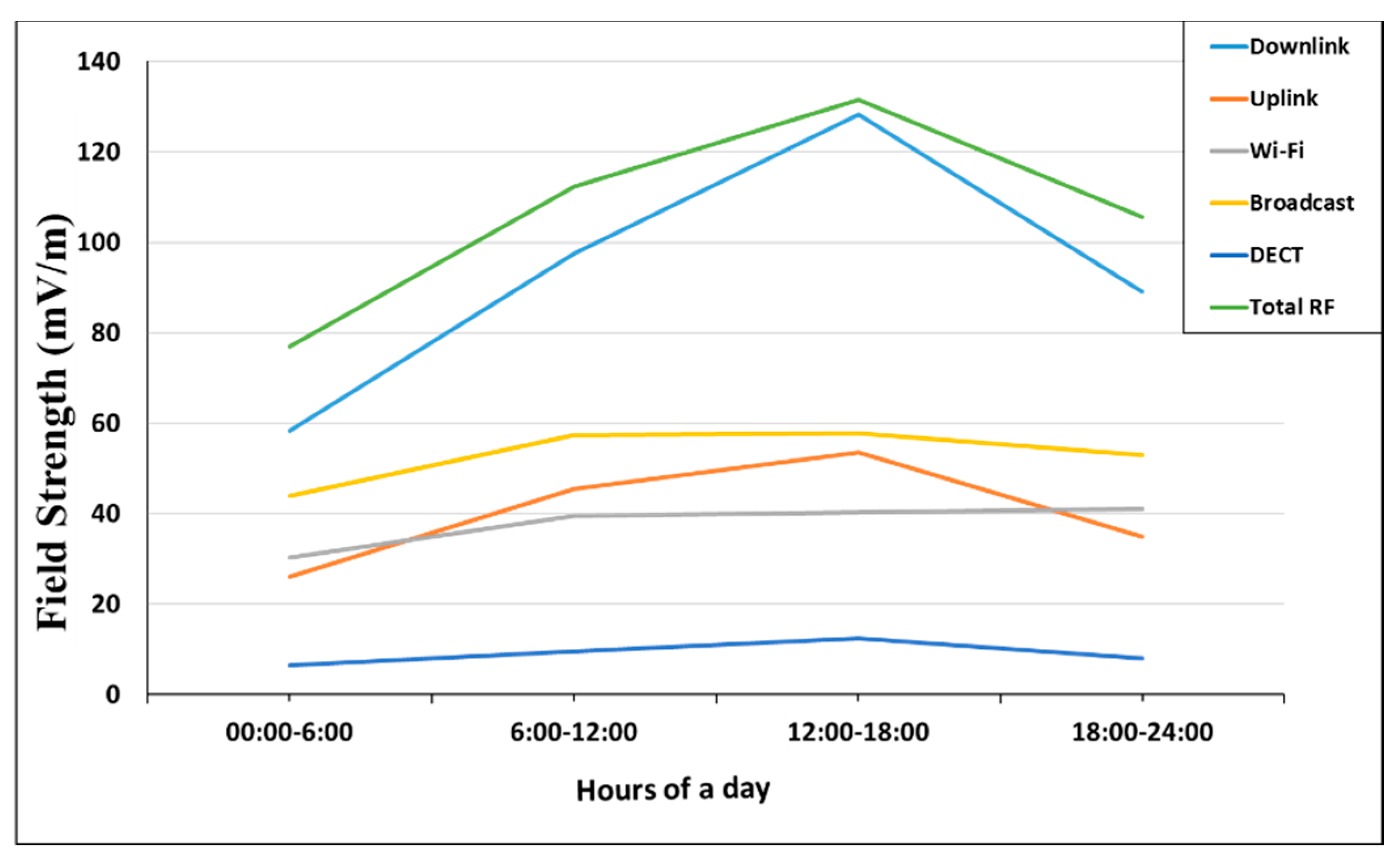Personal Exposure to Radio Frequency Electromagnetic Fields among Australian Adults
Abstract
1. Introduction
2. Materials and Methods
2.1. Study Design and Participant Recruitment
2.2. Personal Exposure Measurement Devices
2.3. Statistical Analysis
3. Results
3.1. Participant Profile
3.2. RF-EMF Exposure Levels
4. Discussion
5. Conclusions
Author Contributions
Funding
Conflicts of Interest
References
- Roser, K.; Schoeni, A.; Struchen, B.; Zahner, M.; Eeftens, M.; Frohlich, J.; Röösli, M. Personal radiofrequency electromagnetic field exposure measurements in Swiss adolescents. Environ. Int. 2017, 99, 303–314. [Google Scholar] [CrossRef] [PubMed]
- Bolte, J.F.; Eikelboom, T. Personal radiofrequency electromagnetic field measurements in The Netherlands: Exposure level and variability for everyday activities, times of day and types of area. Environ. Int. 2012, 48, 133–142. [Google Scholar] [CrossRef] [PubMed]
- Martens, A.L.; Slottje, P.; Meima, M.Y.; Beekhuizen, J.; Timmermans, D.; Kromhout, H.; Smid, T.; Vermeulen, R.C.H. Residential exposure to RF-EMF from mobile phone base stations: Model predictions versus personal and home measurements. Sci. Total Environ. 2016, 550, 987–993. [Google Scholar] [CrossRef] [PubMed]
- Bolte, J.F.B. Lessons learnt on biases and uncertainties in personal exposure measurement surveys of radiofrequency electromagnetic fields with exposimeters. Environ. Int. 2016, 94, 724–735. [Google Scholar] [CrossRef] [PubMed]
- Joseph, W.; Frei, P.; Roosli, M.; Thuroczy, G.; Gajsek, P.; Trcek, T.; Bolte, J.; Vermeeren, G.; Mohler, E.; Juhász, P.; et al. Comparison of personal radio frequency electromagnetic field exposure in different urban areas across Europe. Environ. Res. 2010, 110, 658–663. [Google Scholar] [CrossRef] [PubMed]
- Van Deventer, E.; van Rongen, E.; Saunders, R. WHO research agenda for radiofrequency fields. Bioelectromagnetics 2011, 32, 417–421. [Google Scholar] [CrossRef] [PubMed]
- Bhatt, C.; Thielens, A.; Billah, B.; Redmayne, M.; Abramson, M.J.; Sim, M.R.; Vermeulen, R.; Martens, L.; Joseph, W.; Benke, G. Assessment of personal exposure from radiofrequency-electromagnetic fields in Australia and Belgium using on-body calibrated exposimeters. Environ. Res. 2016, 151, 547–563. [Google Scholar] [CrossRef] [PubMed]
- Bhatt, C.R.; Thielens, A.; Redmayne, M.; Abramson, M.J.; Billah, B.; Sim, M.R.; Vermeulen, R.; Martens, L.; Joseph, W.; Benke, G. Measuring personal exposure from 900 MHz mobile phone base stations in Australia and Belgium using a novel personal distributed exposimeter. Environ. Int. 2016, 92, 388–397. [Google Scholar] [CrossRef] [PubMed]
- Roosli, M.; Frei, P.; Bolte, J.; Neubauer, G.; Cardis, E.; Feychting, M.; Gajsek, P.; Heinrich, S.; Joseph, W.; Mann, S.; et al. Conduct of a personal radiofrequency electromagnetic field measurement study: Proposed study protocol. Environ. Health 2010, 9, 23. [Google Scholar] [CrossRef] [PubMed]
- Durrenberger, G.; Frohlich, J.; Roosli, M.; Mattsson, M.O. EMF monitoring-concepts, activities, gaps and options. Int. J. Environ. Res. Public Health 2014, 11, 9460–9479. [Google Scholar] [CrossRef] [PubMed]
- Joseph, W.; Verloock, L. Influence of mobile phone traffic on base station exposure of the general public. Health Phys. 2010, 99, 631–688. [Google Scholar] [CrossRef] [PubMed]
- Sagar, S.; Adem, S.M.; Struchen, B.; Loughran, S.P.; Brunjes, M.E.; Arangua, L.; Dalvie, M.A.; Croft, R.J.; Jerrett, M.; Moskowitz, J.M.; et al. Comparison of radiofrequency electromagnetic field exposure levels in different everyday microenvironments in an international context. Environ. Int. 2018, 114, 297–306. [Google Scholar] [CrossRef] [PubMed]
- Thielens, A.; van den Bossche, M.; Brzozek, C.; Bhatt, C.R.; Abramson, M.J.; Benke, G.; Martens, L.; Joseph, W. Representativeness and repeatability of microenvironmental personal and head exposures to radio-frequency electromagnetic fields. Environ. Res. 2018, 162, 81–96. [Google Scholar] [CrossRef] [PubMed]
- FieldsatWork GmbH, Sonneggstrasse 60, 8006 Zürich, Switzerland. Available online: www.fieldsatwork.ch (accessed on 20 March 2017).
- Urbinello, D.; Joseph, W.; Verloock, L.; Martens, L.; Roosli, M. Temporal trends of radio-frequency electromagnetic field (RF-EMF) exposure in everyday environments across European cities. Environ. Res. 2014, 134, 134–142. [Google Scholar] [CrossRef] [PubMed]
- Urbinello, D.; Joseph, W.; Huss, A.; Verloock, L.; Beekhuizen, J.; Vermeulen, R.; Martens, L.; Röösli, M. Radio-frequency electromagnetic field (RF-EMF) exposure levels in different European outdoor urban environments in comparison with regulatory limits. Environ. Int. 2014, 68, 49–54. [Google Scholar] [CrossRef] [PubMed]
- ICNIRP. ICNIRP statement on the “Guidelines for limiting exposure to time-varying electric, magnetic, and electromagnetic fields (up to 300 GHz)”. Health Phys. 2009, 97, 257–258. [Google Scholar] [CrossRef] [PubMed]
- Gajsek, P.; Ravazzani, P.; Wiart, J.; Grellier, J.; Samaras, T.; Thuroczy, G. Electromagnetic field exposure assessment in Europe radiofrequency fields (10 MHz-6 GHz). J. Expo. Sci. Environ. Epidemiol. 2015, 25, 37–44. [Google Scholar] [CrossRef] [PubMed]
- Birks, L.E.; Struchen, B.; Eeftens, M.; van Wel, L.; Huss, A.; Gajsek, P.; Kheifets, L.; Gallastegi, M.; Dalmau-Bueno, A.; Estarlich, M.; et al. Spatial and temporal variability of personal environmental exposure to radio frequency electromagnetic fields in children in Europe. Environ. Int. 2018, 117, 204–214. [Google Scholar] [CrossRef] [PubMed]
- Karipidis, K.; Henderson, S.; Wijayasinghe, D.; Tjong, L.; Tinker, R. Exposure to radiofrequency electromagnetic fields from Wi-Fi in Australian schools. Radiat. Prot. Dosimetry 2017, 175, 432–439. [Google Scholar] [CrossRef] [PubMed]
- Bhatt, C.R.; Redmayne, M.; Billah, B.; Abramson, M.J.; Benke, G. Radiofrequency-electromagnetic field exposures in kindergarten children. J. Expo. Sci. Environ. Epidemiol. 2017, 27, 497–504. [Google Scholar] [CrossRef] [PubMed]
- Frei, P.; Mohler, E.; Neubauer, G.; Theis, G.; Burgi, A.; Frohlich, J.; Braun-Fahrländer, C.; Bolte, J.; Egger, M.; Röösli, M. Temporal and spatial variability of personal exposure to radio frequency electromagnetic fields. Environ. Res. 2009, 109, 779–785. [Google Scholar] [CrossRef] [PubMed]
- Viel, J.F.; Cardis, E.; Moissonnier, M.; de Seze, R.; Hours, M. Radiofrequency exposure in the French general population: Band, time, location and activity variability. Environ. Int. 2009, 35, 1150–1154. [Google Scholar] [CrossRef] [PubMed]
- Viel, J.F.; Tiv, M.; Moissonnier, M.; Cardis, E.; Hours, M. Variability of radiofrequency exposure across days of the week: A population-based study. Environ. Res. 2011, 111, 510–513. [Google Scholar] [CrossRef] [PubMed]
- Buckus, R.; Strukcinskiene, B.; Raistenskis, J.; Stukas, R.; Sidlauskiene, A.; Cerkauskiene, R.; Isopescu, D.N.; Stabryla, J.; Cretescu, I. A Technical Approach to the Evaluation of Radiofrequency Radiation Emissions from Mobile Telephony Base Stations. Int. J. Environ. Res. Public Health 2017, 14, 244. [Google Scholar] [CrossRef] [PubMed]
- Inyang, I.; Benke, G.; McKenzie, R.; Abramson, M. Comparison of measuring instruments for radiofrequency radiation from mobile telephones in epidemiological studies: Implications for exposure assessment. J. Expo. Sci. Environ. Epidemiol. 2008, 18, 134–141. [Google Scholar] [CrossRef] [PubMed]
- Aerts, S.; Wiart, J.; Martens, L.; Joseph, W. Assessment of long-term spatio-temporal radiofrequency electromagnetic field exposure. Environ. Res. 2018, 161, 136–143. [Google Scholar] [CrossRef] [PubMed]
- Bhatt, C.R.; Redmayne, M.; Abramson, M.J.; Benke, G. Instruments to assess and measure personal and environmental radiofrequency-electromagnetic field exposures. Australas Phys. Eng. Sci. Med. 2016, 39, 29–42. [Google Scholar] [CrossRef] [PubMed]
- De Miguel-Bilbao, S.; Blas, J.; Ramos, V. Effective Analysis of Human Exposure Conditions with Body-worn Dosimeters in the 2.4 GHz Band. J. Vis. Exp. 2018, 135, e56525. [Google Scholar] [CrossRef] [PubMed]
- De Miguel-Bilbao, S.; Ramos, V.; Blas, J. Responses to comments on assessment of polarization dependence of body shadow effect on dosimetry measurements in the 2.4 GHz band. Bioelectromagnetics 2017, 38, 650–652. [Google Scholar] [CrossRef] [PubMed]
- Rodriguez, B.; Blas, J.; Lorenzo, R.M.; Fernandez, P.; Abril, E.J. Statistical perturbations in personal exposure meters caused by the human body in dynamic outdoor environments. Bioelectromagnetics 2011, 32, 209–217. [Google Scholar] [CrossRef] [PubMed]
- Sagar, S.; Struchen, B.; Finta, V.; Eeftens, M.; Roosli, M. Use of portable exposimeters to monitor radiofrequency electromagnetic field exposure in the everyday environment. Environ. Res. 2016, 150, 289–298. [Google Scholar] [CrossRef] [PubMed]




| Characteristics | n (%) |
|---|---|
| Age, mean ± SD (years) | 36.9 ± 12.5 |
| 18–24 years | 8 (12.7) |
| 25–34 years | 26 (41.3) |
| 35–44 years | 14 (22.2) |
| 45+ years | 15 (23.8) |
| Sex | |
| Female | 42 (66.7) |
| Race/Ethnicity | |
| Caucasian | 33 (52.4) |
| Asian | 23 (36.5) |
| Other | 7 (11.1) |
| Residential location (n = 56) | |
| Metropolitan | 55 (98.2) |
| Education | |
| High school or less | 25 (39.7) |
| Beyond high school | 38 (60.3) |
| Occupation | |
| Office support/admin/finance | 16(25.5) |
| Healthcare | 17(27.1) |
| Research | 10(15.8) |
| Education sector | 10(15.8) |
| Other | 10(15.8) |
| Noticed a base station in the vicinity | |
| Yes | 26 (41.3) |
| No | 22 (34.9) |
| Not sure | 15 (23.8) |
| Base station distance from usual residence (median; meters) | 600 |
| Have a Wi-Fi router at home | |
| Yes | 61(96.8) |
| Smart TV connected to Wi-Fi in house | |
| Yes | 38(61.3) |
| Frequency Bands | Mean | Median | 25th, 75th, 99th Percentiles | Percent of Median Total RF-EMF (%) |
|---|---|---|---|---|
| FM Radio | 23.1 | 18 | 15, 26, 110 | 8.4 |
| DVB-T (TV) | 29.0 | 24 | 14, 40, 91 | 11.2 |
| LTE 800 MHz DL | 6.7 | 6 | 5, 7, 22 | 2.8 |
| LTE 800 MHz UL | 6.2 | 5 | 4, 6, 18 | 2.3 |
| GSM 900 MHz DL | 28.4 | 22 | 15, 33, 147 | 10.2 |
| GSM 900 MHz UL | 26.0 | 24 | 12, 35, 72 | 11.2 |
| GSM 1800 MHz DL | 32.5 | 29 | 18, 41, 104 | 13.5 |
| GSM 1800 MHz UL | 4.1 | 3 | 2, 5,13 | 1.4 |
| DECT | 9.2 | 8 | 5, 12, 35 | 3.7 |
| UMTS 2100 MHz DL | 18.9 | 16 | 9, 23, 83 | 7.4 |
| UMTS 2100 MHz UL | 2.4 | 2 | 1, 3, 10 | 0.9 |
| ISM 2.4 GHz (WLAN) | 37.1 | 23 | 15, 35, 62 | 10.7 |
| LTE 2600 MHz DL | 7.7 | 5 | 3, 11, 40 | 2.3 |
| LTE 2600 MHz UL | 1.7 | 2 | 1, 2, 10 | 0.9 |
| WiMax 3.5 GHz | 1.4 | 1 | 1, 1, 2 | 0.5 |
| ISM 5.8 GHz | 5.6 | 3 | 1, 7, 38 | 1.4 |
| Total a | 233.3 | 215 | 158, 262, 720 | 100.0 |
© 2018 by the authors. Licensee MDPI, Basel, Switzerland. This article is an open access article distributed under the terms and conditions of the Creative Commons Attribution (CC BY) license (http://creativecommons.org/licenses/by/4.0/).
Share and Cite
Zeleke, B.M.; Brzozek, C.; Bhatt, C.R.; Abramson, M.J.; Croft, R.J.; Freudenstein, F.; Wiedemann, P.; Benke, G. Personal Exposure to Radio Frequency Electromagnetic Fields among Australian Adults. Int. J. Environ. Res. Public Health 2018, 15, 2234. https://doi.org/10.3390/ijerph15102234
Zeleke BM, Brzozek C, Bhatt CR, Abramson MJ, Croft RJ, Freudenstein F, Wiedemann P, Benke G. Personal Exposure to Radio Frequency Electromagnetic Fields among Australian Adults. International Journal of Environmental Research and Public Health. 2018; 15(10):2234. https://doi.org/10.3390/ijerph15102234
Chicago/Turabian StyleZeleke, Berihun M., Christopher Brzozek, Chhavi Raj Bhatt, Michael J. Abramson, Rodney J. Croft, Frederik Freudenstein, Peter Wiedemann, and Geza Benke. 2018. "Personal Exposure to Radio Frequency Electromagnetic Fields among Australian Adults" International Journal of Environmental Research and Public Health 15, no. 10: 2234. https://doi.org/10.3390/ijerph15102234
APA StyleZeleke, B. M., Brzozek, C., Bhatt, C. R., Abramson, M. J., Croft, R. J., Freudenstein, F., Wiedemann, P., & Benke, G. (2018). Personal Exposure to Radio Frequency Electromagnetic Fields among Australian Adults. International Journal of Environmental Research and Public Health, 15(10), 2234. https://doi.org/10.3390/ijerph15102234






